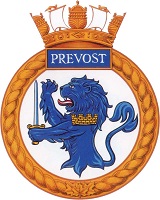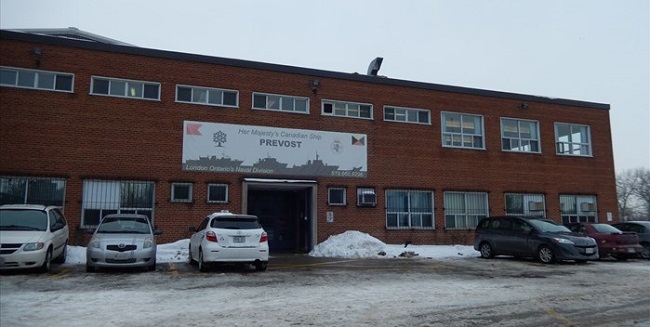|
HMCS PREVOST
London Division RCNVR
London, Ontario
London Division Royal Canadian Naval Volunteer Reserve (RCNVR) was organized following a visit in July by Commander E. R. Mainguy, RCN. Authority for this decision was received together with the appointment of E. E. Hart in command, as a lieutenant, 8 August 1938. The division was to consist of a half ship's company – 6 officers and 45 men. Quarters for the division were situated on the second floor of the Darch Building on Talbot Street, and the Market Square was used for parade ground activities.
After the outbreak of war, and the apparent inadequacy of the quarters, a move was made on 15 November 1939, to the Carling Block at Richmond and Carling streets, a property which had been vacated by the Postal Department upon completion of the Federal Building.
The decision, in 1941, to create independent commands in all shore establishments, brought about the search for appropriate names. As all Naval Divisions were affected, and to perpetuate names of ships that had served Naval Forces, but whose names were not currently allocated, it was decided to rename the division, for the most part, after ships that had served on the Great Lakes during the War of 1812. HMCS PREVOST, named after HMS Lady PREVOST, a schooner brig serving with the Royal Navy's Lake Erie squadron, so named in honour of the wife of Sir George PREVOST, the then Governor General of Canada and Commander-in-Chief, of the British Forces in North America. The commissioning pennant was hoisted on 1 November 1941.
In the interest of operational efficiency, the Royal Canadian Navy had to employ a common language, English, since the majority of its members were English-speaking. Canadians speaking only French were recruited, but their inadequate knowledge of English, produced high percentages of failures among the French-speaking recruits. In the summer of 1941 an English language course was established at HMCS MONTCALM at Quebec City, Quebec. Little progress was made, however, and in 1943 the school was transferred to HMCS PREVOST. The naval schoolmasters were professional language teachers, and the ratings were quartered with English-speaking families in the city. At the end of a three-month course the men were returned to their respective divisions for further training and subsequent draft to HMCS CORNWALLIS. The school was moved to HMCS CORNWALLIS in January 1945.
Another facet of training during this time was that of civilians interested in the Navy generally but particularly in HMCS PREVOST. Many were instructed in navigation by Alexander H. Jeffery, Q.C. and Professor R.L. Allen of the University of Western Ontario, together with the co-operation of J. Gordon Thompson in the use of his yacht. During the period of hostility of World War II, HMCS PREVOST enrolled 4,480 officers, ratings and members of the Women's Royal Naval Service ("wrens") into the Royal Canadian Navy.
The Commodore Walter Hose Efficiency Trophy was won by HMCS PREVOST, under the command of Lieutenant-Commander J.R. Hunter RCNVR in 1941 and 1942 and again in 1943 and became permanent property of the division.
At the close of hostilities, HMCS PREVOST was converted from a wartime establishment to a permanent Naval Division. Specialized training equipment, including gunnery, ASDIC, radar, communication, seamanship and engineering was installed and recruiting commenced. Permanent force staff officers and supply officers together with their staff were appointed to assist with the administration and specialized training.
For practical training in seamanship, two 14-metre (46 ft) harbour craft, one 7.6-metre (25 ft) diesel motor boat, one 9.8-metre (32 ft) cutter, two 7.9-metre (26 ft) whalers and one 4.3-metre (14 ft) Admiralty dinghy were placed in commission at Port Stanley, Ontario. In August 1949 one 34-metre (112 ft) Fairmile motor launch, HMCS RACCOON, converted to diesel power, replaced the two harbour craft.
In October 1950 the boathouse property, situated immediately south of the lift bridge on the west side of the harbour at Port Stanley, was acquired. The following year a building was moved from the Royal Canadian Air Force (RCAF) Station at Fingal, Ontario and erected at the new site. A flag mast, two sets of davits, a crane and other items for seamanship training were provided and the property fenced in.
Naval Headquarters decided, in 1952, to re-activate the competition for efficiency. A silver replica of the Destroyer-Escort class was donated by Vice Admiral H. T. W. Grant and a system of assessment was prepared and promulgated to all Naval Divisions. A second trophy was also activated for the presentation to the Division next in line and was known as the "Runner Up" trophy.
HMCS PREVOST, under the command of Commander E.G. Bride, RCNR won the Efficiency Trophy for the training year 1953–1954 and tied with HMCS CHIPPAWA for the 1954–1955 training year.
After eighteen years in the Carling Block, and many attempts to secure new and better quarters, a new construction program was launched in February 1956, and on 30 July 1957 the new building at the forks of the Thames River was accepted from the contractors, the ensign hoisted and the move from the Carling Block undertaken. On 23 November 1957 the building was officially opened by the Minister of National Defence, Honourable George R. Pearkes, V.C., assisted by Commodore A.H.G. Storrs, RCN, Rear Admiral K.F. Adams, RCN, Mayor Ray Dennis and the Rev. R.H. McColl, RCNR.
HMCS PREVOST under the command of Captain G.A. MacLachlan RCNR won the Runner Up Trophy for the 1958–1959 training season and again for the 1961–1962 period.
Late in 1963, the Minister of National Defence announced a drastic curtailment of expenditures for defence purposes. Among "economies" to be affected was the closing of six Naval Reserve Divisions. Among those six, was HMCS PREVOST.
The paying off of the land-locked "stone frigate", the reality of service integration as the building was turned over to the Western Ontario Area Command Headquarters for the use of Army militia units.
PREVOST detachment office stood up in A Block CFB London in 1977. Staffing, and recruiting began again to enroll personnel for PREVOST detachment. Bob Leckie came out of retirement to recruit and manage the detachment office in "A" block at CFB London. During the early 1980s the Naval Reserve Detachment continued to grow in London. Within three years PREVOST grew to 45 personnel. It was called the PREVOST detachment of HMCS Star located in Hamilton, Ontario. Star performed most administrative functions for the detachment. Chief Petty Officer Bill Ross was the full-time chief administrator for the growing unit. Initially only Marine Engineers were recruited as the Naval reserve had a shortage at the time, these PREVOST engineers once trained, were used to augment many other units on their training weekends on board various ships on either coast.
PREVOST detachment moved from CFB London A Block to its present location, PREVOST armories on Becher Street then home to 22 Service Battalion and 4 RCR, and the decision to re-commission PREVOST as a Naval Reserve Division of Maritime Command was made. HMCS PREVOST was re-commissioned as a Naval Reserve Division of Maritime Command on 29 September 1990 by Vice Admiral C.M. Thomas, CMM, CD, the Vice Chief of the Defence Staff.
Freedom of the City was granted to HMCS PREVOST under the command of Lieutenant-Commander M. Hoare by Mayor Diane Haskett on 31 October 1998. In October 1998, the war memorial to HMCS PREVOST sailors lost at sea was repatriated to HMCS PREVOST from St Paul's Anglican Cathedral of London, Ontario, where it had been safeguarded since 1964. The Engineering trade lost its traditional place as the largest division at HMCS PREVOST in 2002, when the Operations department displaced it. PREVOST adopted a new motto, "By Valour not Deception".
|


